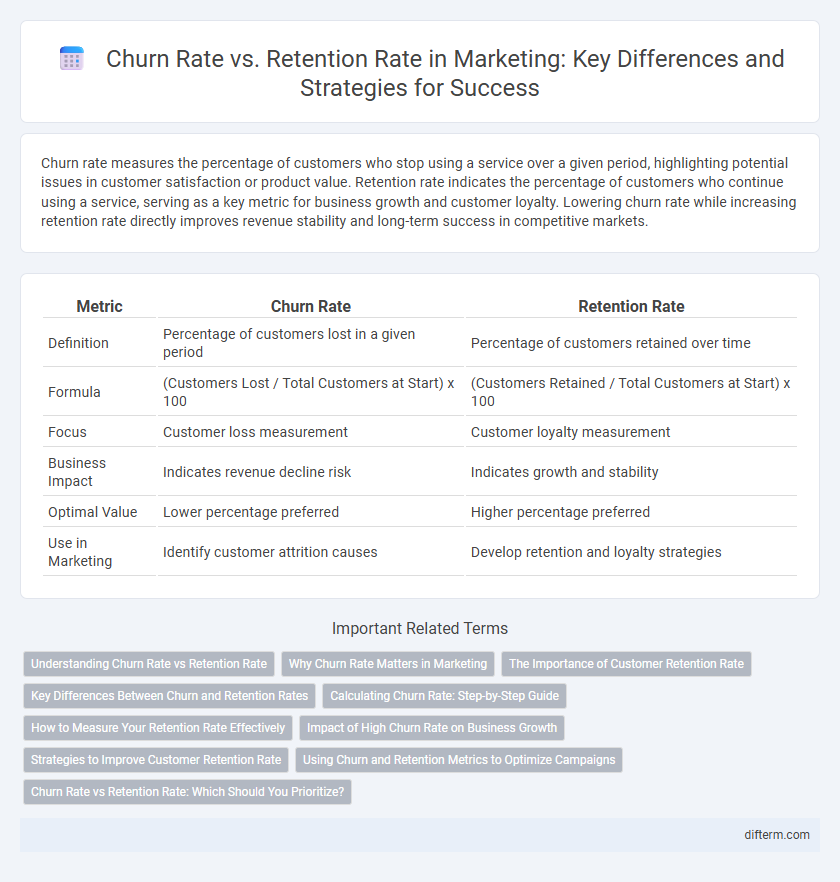Churn rate measures the percentage of customers who stop using a service over a given period, highlighting potential issues in customer satisfaction or product value. Retention rate indicates the percentage of customers who continue using a service, serving as a key metric for business growth and customer loyalty. Lowering churn rate while increasing retention rate directly improves revenue stability and long-term success in competitive markets.
Table of Comparison
| Metric | Churn Rate | Retention Rate |
|---|---|---|
| Definition | Percentage of customers lost in a given period | Percentage of customers retained over time |
| Formula | (Customers Lost / Total Customers at Start) x 100 | (Customers Retained / Total Customers at Start) x 100 |
| Focus | Customer loss measurement | Customer loyalty measurement |
| Business Impact | Indicates revenue decline risk | Indicates growth and stability |
| Optimal Value | Lower percentage preferred | Higher percentage preferred |
| Use in Marketing | Identify customer attrition causes | Develop retention and loyalty strategies |
Understanding Churn Rate vs Retention Rate
Churn rate measures the percentage of customers who stop using a product or service within a specific period, serving as a critical indicator of customer loss. Retention rate quantifies the proportion of customers who continue using the product over time, reflecting customer loyalty and satisfaction. Understanding the relationship between churn rate and retention rate helps businesses optimize marketing strategies to reduce customer attrition and enhance long-term revenue growth.
Why Churn Rate Matters in Marketing
Churn rate measures the percentage of customers who stop using a product or service over a specific period, directly impacting revenue predictability and growth strategies. High churn rates indicate underlying issues in customer satisfaction, product value, or competitive positioning, leading marketers to allocate resources toward retention efforts. Understanding churn rate allows marketing teams to optimize customer lifetime value (CLV), improve targeting, and tailor personalized campaigns that enhance loyalty and reduce attrition.
The Importance of Customer Retention Rate
Customer retention rate directly impacts long-term revenue by indicating the percentage of customers who continue purchasing over time, making it a critical metric for sustainable growth. Unlike churn rate, which measures customer loss, retention rate highlights customer loyalty and engagement, essential for optimizing marketing strategies. High retention reduces acquisition costs and enhances lifetime customer value, driving profitability in competitive markets.
Key Differences Between Churn and Retention Rates
Churn rate measures the percentage of customers lost within a specific period, while retention rate indicates the percentage of customers who continue using a product or service over time. A high churn rate signals customer dissatisfaction or competitive threats, whereas a high retention rate reflects customer loyalty and effective engagement strategies. Businesses prioritize retention rate to maximize lifetime value and reduce acquisition costs, making these metrics crucial for assessing marketing success.
Calculating Churn Rate: Step-by-Step Guide
Calculate churn rate by dividing the number of customers lost during a specific period by the total customers at the period's start, then multiply by 100 to get a percentage. For example, if a business began with 1,000 customers and lost 50 over a month, the churn rate equals (50/1,000) x 100 = 5%. Tracking churn rate alongside retention rate facilitates identifying customer behavior patterns and optimizing marketing strategies to improve loyalty and revenue.
How to Measure Your Retention Rate Effectively
To measure your retention rate effectively, track the percentage of customers who continue purchasing over a specified period compared to the total number of customers at the start. Use cohort analysis to segment customers by acquisition date and analyze their repeat purchase behavior for more precise insights. Incorporate customer engagement metrics, such as active usage frequency and subscription renewals, to complement retention rate data and understand long-term loyalty.
Impact of High Churn Rate on Business Growth
A high churn rate significantly hinders business growth by reducing the lifetime value of customers and increasing acquisition costs. Companies facing elevated churn struggle to maintain steady revenue streams and lose opportunities for upselling and cross-selling. Enhancing customer retention through targeted strategies directly boosts profitability and market stability.
Strategies to Improve Customer Retention Rate
Customer retention rate can be improved by implementing personalized marketing strategies, leveraging customer feedback to enhance product offerings, and utilizing loyalty programs to increase engagement. Reducing churn rate requires proactive identification of at-risk customers through data analytics and providing targeted incentives to encourage continued usage. Consistent communication and delivering exceptional customer experiences foster long-term loyalty and sustainable growth in competitive markets.
Using Churn and Retention Metrics to Optimize Campaigns
Churn rate and retention rate are critical metrics for evaluating customer loyalty and campaign effectiveness in marketing. By analyzing churn data, marketers can identify patterns indicating customer dissatisfaction or disengagement, allowing for targeted interventions to reduce attrition. Simultaneously, leveraging retention metrics helps optimize campaigns by focusing resources on strategies that enhance customer lifetime value and foster long-term engagement.
Churn Rate vs Retention Rate: Which Should You Prioritize?
Churn rate measures the percentage of customers lost over a specific period, while retention rate reflects the percentage of customers who continue using a product or service. Prioritizing retention rate often leads to higher long-term revenue because retaining customers is typically more cost-effective than acquiring new ones. Analyzing both metrics together provides a balanced view, but focusing on strategies that improve retention drives sustainable business growth and reduces churn impact.
Churn rate vs retention rate Infographic

 difterm.com
difterm.com